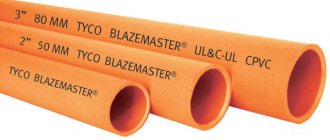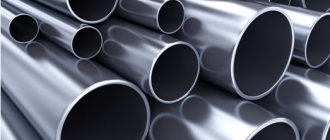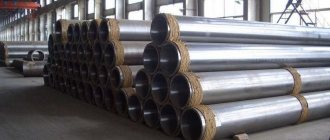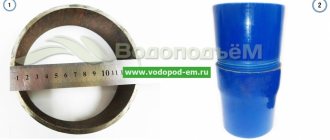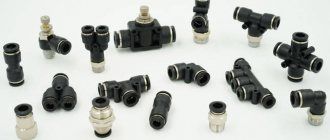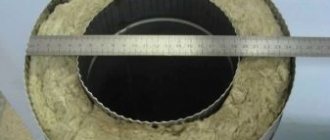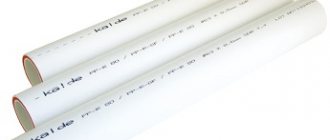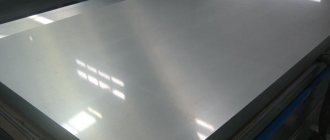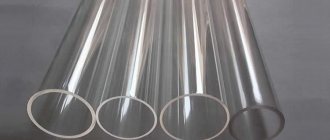Pipe application area
The profile pipe has many advantages compared to standard round pipes:
- low cost. A hollow square-section metal pipe is less expensive than analogues made of wood and can last longer;
- ease of installation. Thanks to its qualities, the pipe can be easily bent. The low weight of the products facilitates the process of transportation and self-installation;
- high resistance to damage. Profile pipes are not susceptible to mechanical stress. Pipes are protected from corrosion by a special coating;
- resistance to temperature changes. The pipe does not deform at both low and high air temperatures;
- reliability. Thanks to the stiffening ribs, the profile pipe can withstand quite heavy loads, and for a long period of time.
The main advantages of pipes determine the scope of their application. Pipes of various sections are used:
- for creating building frames, including as transverse beams, trusses, columns and vertical posts, as they are distinguished by their ability to withstand the load of the cladding and durability;
Frame of a residential building made of profile pipes
- for the construction of frames for gazebos, swings, benches and other small architectural forms;
- for the construction of fences, gates, wickets, both as main pillars and as transverse ribs;
Swing and fence frame made of square pipes
- to create pieces of furniture (tables, chairs, etc.).
Furniture items made from profile pipes
- as protective channels for various communications.
How to make a chair from pipes yourself, watch the video.
Source: vse-o-trubah.ru
The use of pipes in several main areas of construction.
These include: the construction of buildings and structures, design and modification of interiors, mechanical engineering and even the food industry; in some cases, profile pipes are used as pipeline parts, allowing the creation of durable and economical structures. Profile pipes having the same and measured length are packaged in square and hexagonal bags. They have their own peculiarity, which is the following: each of these profile pipes is covered at the ends with plugs that prevent moisture from entering the pipe and, in some cases, are color-coded so that you can immediately determine the standard size of the packaged profile pipe. A guarantee of high quality is ensured by the fact that all profile pipes are subjected to full non-destructive magnetoelectric testing, and are also tested in a hydraulic press at a pressure of 25-60 atmospheres. Also, some manufacturers of profile pipes, for example Severstal, treat shipped profile pipes with a special lubricant composition, which provides additional moisture protection.
In the process of constructing monolithic buildings, sports facilities, various industrial structures and terminals, as well as in the construction of bridges and crossings, masts and cell towers, it is necessary to use profile pipe as the most suitable material for these purposes. In terms of its structure, the profile pipe is a hollow bent-welded structure that has minimal weight and a lot of advantages.
Steel grades of profile pipes
Carbon, alloy and high-alloy steels are used for the manufacture of profile pipes. They all have their own characteristics, which are given to them by the presence of one or another chemical element in their composition.
From this article you will learn what grades of steel are used in the production of profile pipes, and you will also be able to read more details about the popular materials used in the manufacture of such products.
Why is it so important what steel the profile pipe is made of?
This indicator affects the main characteristics of the product. Steel grades and pipe weight are inextricably linked. The brand also affects the durability of the product, its ability to withstand high and low temperatures, possible and maximum loads, its ability to withstand corrosion and atmospheric conditions, as well as its appearance.
Used grades of profile pipe steel: list and details
The choice of a specific material also depends on the method of manufacturing the product.
For example, pipes with a square cross-section and dimensions from 10 by 10 to 40 by 40 are made from cold-rolled steel, as well as with a rectangular cross-section, with dimensions from 12 by 10 to 60 by 40, with a wall thickness from 0.6 mm to 2 mm. The following steel grades are used: 08ps (details at https://atl-met.ru/stal-08ps), 1ps (more information here: https://atl-met.ru/stal-st1ps), 2ps.
From hot-rolled steel grades 3SP, 1ps, steel 2PS, square pipes with dimensions from 15 by 15 to 150 by 150 and rectangular pipes, with dimensions from 20 by 10 to 180 by 150, with wall thicknesses from 1.5 to 5 millimeters are made.
Closed profiles used for building structures make it possible to create square products with dimensions from 60 by 60 to 300 by 300 and rectangular ones, from 80 by 60 to 350 by 250. Steels 3sp/ps5 and 09G2S are used for them.
You can find out more information about profile pipes made of steel 20 at the link: https://atl-met.ru/stal-20. If you are interested in steel grade 10, which is also used in the manufacture of such products, then go to the appropriate page: https://atl-met.ru/stal-10
Profile pipe made of steel 09G2S: the most common option
These products are typically required for commercial and large-scale construction and industrial applications.
Low alloy steel grade 09G2S is very popular in the manufacture of such products.
The pipe obtained from such material has an attractive appearance, a minimum number of seams and high manufacturability.
Source: atl-met.ru
Assortment of steel profile rectangular pipes
The use of these products is most rational in structures for which the direction of the main load is known. It is used in the construction of frames, columns, racks, and floor beams. The range of rectangular profile pipes - seamless hot- and cold-rolled, electric-welded, manufactured by furnace welding - is determined by GOST 8645-68.
Advantages of metal products with a rectangular profile:
- light weight, ensuring convenient installation and transportation;
- high bending strength;
- right angles, providing convenient storage and good compatibility with flat surfaces;
- possibility of implementing different design and architectural solutions.
Table of assortment of profile pipes: the most popular sizes
| Dimensions, axb, mm | Wall thickness, s, mm | Weight 1 m, kg | Meters per ton | Dimensions, axb, mm | Wall thickness, s, mm | Weight 1 m, kg | Meters per ton |
| 15x10 | 1,0 | 0,348 | 2874 | 30x15 | 1,0 | 0,661 | 1513 |
| 1,5 | 0,488 | 2049 | 1,5 | 0,959 | 1043 | ||
| 2,0 | 0,605 | 1653 | 2,0 | 1,23 | 813 | ||
| 20x10 | 1,0 | 0,426 | 2347 | 3,0 | 1,71 | 585 | |
| 1,5 | 0,605 | 1653 | 30x20 | 1,0 | 0,74 | 1351 | |
| 2,0 | 0,762 | 1312 | 1,5 | 1,08 | 926 | ||
| 20x15 | 1,0 | 0,505 | 1980 | 2,0 | 1,39 | 719 | |
| 1,5 | 0,723 | 1383 | 3,0 | 1,95 | 513 | ||
| 2,0 | 0,919 | 1088 | 35x15 | 1,5 | 1,08 | 926 | |
| 25x10 | 1,0 | 0,505 | 1980 | 2,0 | 1,39 | 719 | |
| 1,5 | 0,723 | 1383 | 2,5 | 1,68 | 595 | ||
| 2,0 | 0,919 | 1088 | 3,0 | 1,95 | 573 | ||
| 2,5 | 1,090 | 917 | 3,5 | 2,2 | 455 | ||
| 25x15 | 1,0 | 0,583 | 1715 | 40x20 | 2,0 | 1,7 | 588 |
| 1,5 | 0,841 | 1189 | 3,0 | 2,42 | 413 | ||
| 2,0 | 1,08 | 926 | 4,0 | 3,05 | 328 | ||
| 2,5 | 1,29 | 775 | 45x20 | 2,0 | 1,86 | 538 | |
| 30x10 | 1,0 | 0,583 | 1715 | 3,0 | 2,66 | 376 | |
| 1,5 | 0,841 | 1189 | 4,0 | 3,36 | 298 | ||
| 2,0 | 1,08 | 926 | 50x30 | 3,0 | 3,36 | 298 | |
| 3,0 | 1,48 | 676 | 4,0 | 4,3 | 233 |
.. | Types of profile pipe. Production and use of professional pipes. GOSTs and TU.
Types of profile pipe. Production and use of professional pipes. GOSTs and TU.
Profile steel pipe is a metal product of any cross-section except round: square, rectangular, oval or other.
Thus, depending on the cross-section, pipes are divided into:
square profile pipes,
rectangular profile pipes,
According to the production method and deformation method, profile pipes are distinguished:
a) hot- and cold-formed seamless;
b) electric-welded cold-deformed.
According to the types of steel from which the pipes are made, pipes are made:
carbon, low-alloy steels, stainless and aluminum.
According to the method of metal processing, a metal profile pipe is divided into:
Hot-rolled (hot-deformed) and cold-rolled (cold-deformed) seamless pipes,
electric welded pipe - using welding,
electric welded without heat treatment (cold-deformed).
Profile pipes have their own classification according to their purpose:
group A - produced with standardization of steel properties,
group B - produced with standardized mechanical properties and chemical composition of the metal.
Manufacturing of profile pipes
Profile pipes are produced according to two schemes: from round pipes and in a full cycle.
The production technology from round pipes involves passing a cold round pipe through special rollers in a mill, where it takes on a certain shape. Such mills usually produce profile pipes for non-critical elements, for furniture or decoration. Such a low-quality pipe is not used in structures with heavy loads.
The full cycle of production of corrugated pipes includes first the production of a round pipe from a strip (roll of sheet metal) using hot or cold deformation methods. The strip is cut into strips of 5 cm or more using longitudinal cutting, and the resulting strips are welded into one strip. The tape is then wound onto a drum for a continuous further process and passed through a forming mill, where the tape acquires a circular cross-section. At this stage, the round billet can be heated until the metal is completely plastic. Next, this workpiece is subjected to welding: inductor, gas-shielded, and others. In this case, the edges of the product are compressed by the rollers, and a melt is squeezed out - a burr, which is immediately removed using a cutter. The resulting product is cooled with the emulsion, passed through molding rollers to ensure a uniform cross-section along its entire length, and then crimped into a square or rectangular shape. Internal stresses in the pipe are removed by heat treatment, which improves the quality of the produced material. Finally, the pipe is checked for defects and cut into measured lengths.
SevZapAgroPromStroy
Prices for profile pipes are indicated in the “price list for rolled steel” section.There are many types of building reinforcement, for example, beams, angles, channels, which are created for specific areas of application, but there is also universal rolled metal, which is cheaper and, most importantly, much easier to install than specialized rolled metal that can replace these parts with such rolled metal is a steel profile pipe.
These profile pipes usually have a rectangular or square cross-section (as opposed to a circle in the pipes we are used to), and are called rectangular and square pipes, respectively. They are rarely used for installation of utilities, since they are mainly used as construction fittings, hence the name - profile pipes.
The main advantages of profile pipes are: - ease of installation in various structures - replacement of many elements of profile fittings and lower cost in comparison with them - convenient shape, facilitating storage, loading, transportation - resistance to severe static loads and high bending strength - saving metal when construction of buildings - resistance to deformation and changes in temperature - the ability to find non-standard architectural solutions Rectangular and square pipes, like ordinary ones, are divided into different types according to the production method - hot-rolled, cold-rolled, seamless, electric-welded. Moreover, hot-rolled or otherwise hot-deformed pipes become a blank for the production of cold-rolled ones.
Seamless profile pipes are especially popular in systems with increased safety requirements. This type of profile pipe has a clear advantage due to the uniform distribution of the load along the entire perimeter. In pipes with seams, the strength of the areas near the seams should not decrease by more than 10-15% (depending on the type of pipe and scope of application), but the ideal option is a seamless pipe. Such elements are used at the most important, most critical facilities, right up to the external circuits of nuclear power plants.
Profile pipes are made from steel grades St2sp, St2ps, St2kp, St4sp, St4ps, St4kp in accordance with GOST 380, as well as steel grades 10, 10ps, 20, 35, 45, 08kp - in accordance with GOST 1050. These types of calm, semi-quiet and boiling steel are the best correspond in a manner to the technological features of the manufacture of profile pipes. As a rule, carbon steel is used in production without special alloying in order to withstand a certain plasticity of the metal, which allows drawing pipes of various shapes. Pipes are made by heat treatment or without heat treatment.
ELECTRIC-WELDED PROFILE PIPES GOST 13663-86. The profile pipe is made from hot-deformed, cold-deformed, electric-welded or electric-welded cold-deformed general-purpose pipes made of carbon steel.
Electric-welded profile pipes are manufactured with external dimensions from 10 to 100 mm, wall thickness from 1.0 to 5 mm, length: unmeasured length - from 1.5 to 9 m; measured length - from 5 to 9 m; multiple measuring length - any multiplicity not exceeding the lower limit established for measuring pipes.
Pipes are made from steel grades: St2sp, St2ps, St2kp, St4sp, St4ps, St4kp according to GOST 380; 10, 10ps, 20, 35, 45, 08kp according to GOST 1050. Depending on the purpose, pipes should be manufactured in the following groups: A - with standardized mechanical properties; B - with standardization of mechanical properties and chemical composition of steel grades according to GOST 1050-88 and GOST 380-88..
Profile pipes are manufactured either heat-treated or without heat treatment. The ends of the pipe must be cut at right angles; at the request of the consumer, pipes are manufactured without cutting the ends. Hydraulic testing of the pipe and standards for it are determined by agreement between the manufacturer and the consumer.
STEEL SQUARE PIPES (GOST 8639-82) The range of square pipes is regulated by GOST 8639-82. This standard applies to seamless hot-deformed and cold-deformed electric-welded and electric-welded cold-deformed steel pipes.
Pipes are manufactured:
of unmeasured length: - seamless hot-deformed - from 4 to 12.5 m - seamless cold-deformed and electric welded - from 1.5 to 9 m
measured length: - seamless hot-deformed - from 4 to 12.5 m - seamless cold-deformed - from 4.5 to 9 m - electric welded - from 5 to 9 m
length, a multiple of the measured length: - seamless hot-deformed - from 4 to 12.5 m with an allowance for each cut of 5 mm - seamless cold-deformed - from 1.5 to 9 m with an allowance of 5 mm for each cut - electric welded - any multiplicity, not exceeding the lower limit established for measuring pipes
The total length of multiple pipes must not exceed the upper limit of the gauge pipes. The allowance for each multiple is set to 5 mm (unless another allowance is specified in the order) and is included in each ordered multiple. In the cross section of the pipe, the deviation from the right angle should not exceed ±1.5°. The curvature of the pipes should not exceed 2 mm per 1 m of length.
RECTANGULAR STEEL PIPES (GOST 8645-68)
The range of rectangular pipes is regulated by GOST 8645-68. This standard applies to seamless hot-rolled, cold-drawn and electric-welded rectangular steel pipes.
Application of a profile pipe.
The shape of the profile pipe makes it very popular in construction and in the manufacture of all kinds of metal structures. Using profile steel pipes, fences, shopping and sports complexes, bridges, industrial buildings, communication towers, long-span structures containing heavy loads are erected; they can also be used as supports, columns and ceilings, for example, during repairs to create temporary metal structures or laying electrical networks. One cannot do without such a pipe in agricultural engineering. Profiles with side dimensions of 50×50, 40×80, 50×100 are often used.
Profile pipes play an important role not only in large-scale construction; they are a frequently used material in creating furniture frames, erecting fences and making railings, decorative interior decoration, playgrounds, and window bars. In a word, profile steel pipe is used everywhere.
Advantages of a profile pipe.
The main advantage of steel profile pipes is the reduction in the weight of the metal structure along with ease of installation. There is an obvious gain in the mass of material, and therefore in money, while due to the distribution of the load over the entire profile, a very high resistance to loads is maintained. Moreover, the corrosion resistance of the entire structure increases compared to the use of other types of rolled metal. The possibility of using profile pipes on high-voltage lines is due to the possibility of applying an additional coating to the supporting part, which ensures the safety of conductive elements.
Many designers and architects have practically abandoned the use of traditional types of building metal products in favor of a profile closed pipe due to its practicality and ease of use for modern architectural and design solutions.
Our prices for profile rectangular pipes in St. Petersburg and other rolled metal products will pleasantly surprise you. Thus, our company provides a system of discounts for regular customers.
This directory provides information about all types of steel pipes, in particular about stainless pipes, as well as about rolled products, in particular about fittings and steel circles.
What steel are square pipes made from?
Square pipes are a highly sought-after product of pipe factories. Unlike its round counterparts, this type will be of interest not to plumbers, but to installers who specialize in assembling metal structures. Today, the grades of steel used for the production of square pipes in Moscow can be different, which determines the scope of application of a particular product. Let's look at this issue in more detail.
What are square pipes made of?
The main material for the manufacture of square pipes is structural steel. If we talk about specific brands that are acceptable for use for certain products, then they are indicated in the corresponding GOST. The most commonly used steel grades are:
- An ordinary pipe, which, according to GOST, can be made of the following grades of steel: 10 and 10ps, 08kp, St4sp and St4ps, St2sp, 20, St4kp. Each brand must have a specific chemical composition.
- Some manufacturers also add stainless steel to the grades of structural steel. Stainless steel pipes are made from AISI 304 grade. A stainless steel pipe most often differs from a regular pipe not only in its cross-sectional shape, but also in its wall thickness. Therefore, in this case, the necessary choice may be complicated by such a discrepancy.
- Low-alloy steel, grade 09G2S, can also be used in production.
Features of square pipes
Regardless of the grade of steel used in the production of square pipes in Moscow, such products have the following advantages:
- High level of technology.
- Reliability and ease of connection.
- When using such pipes, the construction of various buildings is significantly accelerated. Welded wire is often used together with the profile pipe, which greatly facilitates installation.
- A minimum of welds, as well as the possibility of high-quality welding.
Abroad, most builders prefer square and rectangular pipes. New buildings made of concrete, metal and glass, including residential buildings, banks, offices, sports complexes, etc., are built using square pipes. This material is universal and allows you to easily create bent objects, for example, arched structures.
When purchasing a pipe, it is important that it corresponds to the design documentation; if there is none, it is better to turn to large metal rolling companies.
Source: www.oldor.ru
Assortment of steel profile square pipes
Products with a hollow square internal cross-section are in demand in interior design, the furniture industry, for the manufacture of greenhouses, advertising products, in machine tool construction, the production of non-standard production equipment, and in the construction of fences.
The range of square profile pipes is determined by GOST 8639-82.
Table of assortment of square profile pipes: dimensions and weight
| Wall dimensions, mm | Wall thickness, s, mm | Weight 1 m, kg | Meters per ton | Wall dimensions, mm | Wall thickness, s, mm | Weight 1 m, kg | Meters per ton |
| 10x10 | 1,0 | 0,269 | 3718 | 45x45 | 3,0 | 3,83 | 261 |
| 15x15 | 1,0 | 0,426 | 2347 | 3,5 | 4,4 | 227 | |
| 1,5 | 0,605 | 1653 | 4,0 | 4,93 | 203 | ||
| 20x20 | 1,0 | 0,583 | 1715 | 5,0 | 5,94 | 168 | |
| 1,5 | 0,841 | 1189 | 6,0 | 6,86 | 146 | ||
| 2,0 | 1,075 | 930 | 7,0 | 7,69 | 130 | ||
| 25x25 | 1,0 | 0,74 | 1351 | 8,0 | 8,43 | 119 | |
| 1,5 | 1,07 | 935 | 50x50 | 3,0 | 4,31 | 232 | |
| 2,0 | 1,39 | 719 | 3,5 | 4,94 | 202 | ||
| 2,5 | 1,68 | 595 | 4,0 | 5,56 | 180 | ||
| 3,0 | 1,95 | 513 | 5,0 | 6,73 | 149 | ||
| 30x30 | 2,0 | 1,7 | 588 | 6,0 | 7,8 | 128 | |
| 2,5 | 2,07 | 483 | 7,0 | 8,79 | 114 | ||
| 3,0 | 2,42 | 413 | 8,0 | 9,69 | 103 | ||
| 3,5 | 2,75 | 364 | 60x60 | 3,5 | 6,04 | 166 | |
| 4,0 | 3,04 | 329 | 4,0 | 6,82 | 146,6 | ||
| 35x35 | 2,0 | 2,02 | 495 | 5,0 | 8,3 | 120,5 | |
| 2,5 | 2,46 | 406,5 | 6,0 | 9,69 | 103, | ||
| 3,0 | 2,89 | 346 | 7,0 | 11,0 | 91 | ||
| 3,5 | 3,3 | 303 | 8,0 | 12,2 | 82 | ||
| 4,0 | 3,67 | 272,5 | 70x70 | 4,0 | 8,07 | 124 | |
| 5,0 | 4,37 | 229 | 5,0 | 9,87 | 101 | ||
| 40x40 | 2,0 | 2,33 | 429 | 6,0 | 11,57 | 86 | |
| 2,5 | 2,85 | 351 | 7,0 | 13,19 | 76 | ||
| 3,0 | 3,36 | 298 | 8,0 | 14,7 | 68 | ||
| 4,0 | 4,3 | 233 | 80x80 | 4 | 9,33 | 107 | |
| 5,0 | 5,16 | 194 | 5 | 11,44 | 87 | ||
| 6,0 | 5,92 | 169 | 6 | 13,46 | 74 | ||
| 42x42 | 3,0 | 3,55 | 282 | 7 | 15,38 | 65 | |
| 3,5 | 4,07 | 246 | 8 | 17,22 | 58 | ||
| 4,0 | 4,56 | 219 | 90x90 | 6 | 15,34 | 65 | |
| 5,0 | 5,47 | 183 | 7 | 17,58 | 57 | ||
| 6,0 | 6,3 | 159 | 8 | 19,73 | 51 |
The technical conditions for profiled square and rectangular pipes used for building structures are regulated by GOST 30245-2003, and for profile welded and seamless products for general use - by GOST 13663-86.
Advantages of galvanized metal pipes
Galvanized pipes are steel products coated inside or outside. The galvanizing process is carried out using different technologies:
- electroplating;
- thermal diffusion;
- hot galvanized.
The first method is the most expensive, but with its help you can obtain an even zinc coating with a thickness of 10 to 25 microns. The cheapest method is hot-dip galvanizing, but it does not always provide an even coating.
Thanks to the protective layer, a galvanized steel pipe receives additional positive qualities:
- increased strength;
- resistance to corrosion (compared to conventional pipes, rusts 10 times slower);
- ability to withstand mechanical damage;
- resistance to increased pressure inside (well suited for transporting gases and liquids under pressure);
- ease of installation.
An additional plus is that zinc coating creates unfavorable conditions for microorganisms. Therefore, the inner surface of the pipe will be clean from bacterial plaque even after many years of operation.
GOST galvanized pipes are presented in two options:
- water and gas pipeline – 3262;
- electric welded – 10704.
The applications of galvanized pipe are extensive:
- for laying pipelines;
- for installation of communications (water supply, sewerage, heating);
- for agricultural needs (in irrigation systems, for supplying fertilizers to fields, as a support for young trees, grapes);
- installation of outdoor lighting, advertising objects;
- construction (greenhouse frames, warehouses, repair shops, gyms, parking lots);
- to create drainage systems;
- when creating the frame of furniture and decorative products.
Galvanized pipes are an almost ideal option for use in any area, although they are more expensive than usual. But if you consider that the service life of galvanized material is about 50 years, the cost of purchasing this type of pipe is completely justified.
Production process
Such a pipe, like any rolled metal, can be manufactured in several ways.
The process itself consists of several stages:
- First, metal sheets are fed onto the conveyor using rollers and rollers, they are checked for rust and scale, and such defects are eliminated if necessary.
- Then these sheets are cut into strips, which are subsequently welded together using electric welding equipment.
- After the welding stage, the rectangular part is cooled and tested for compliance with all stated GOST standards.
The second method is seamless production.
In addition to electric welding, the profile square pipe can be cold-deformed and hot-deformed. The essence of the deformation method is that the workpiece acquires the desired shape while passing through the molding machine compartment. This is a seamless production technique. Cold deformation differs from hot deformation in that pipes manufactured by the second method are produced under conditions of high temperatures and pressure.
For seamless production of profile pipes, round blanks are used
There is a third method of production. It is of a combined nature. Using this method, pipes are manufactured in several stages:
- Production of strip - a special blank from a steel sheet.
- Welding the workpiece. As a rough draft, a conventional round electric-welded pipe is used.
- Profile formation. A profile pipe with stiffeners is formed from a round billet using a forming machine with rollers. The corners of such a product will be smoother, and the shape can be square or rectangular.
Upon completion of the deformation, additional checks and controls are carried out in production, and internal stress in the pipes is also relieved.
Where is the VGP pipe used?
Water and gas pipes are made from high carbon steel using special technologies. Thanks to this, the VGP pipe receives additional qualities:
- high mechanical strength and impact resistance;
- resistance to pressure changes inside the pipe;
- immunity to sudden temperature changes and unfavorable external conditions.
Thanks to these characteristics, the use of VGP pipes is possible in various fields:
- laying a gas pipeline;
- installation of water supply systems (centralized or for a private home);
- creation of a heating system;
- construction of various structures (greenhouses, sheds, fences);
- production of furniture frames;
- construction of auxiliary structures (stairs, scaffolding).
VGP pipe in accordance with GOST 3262-75 is produced with different sections and wall thicknesses. This affects the areas of its use.
The outer diameter of the VGP pipe ranges from 10.2-165 mm.
Based on pipe wall thickness, HSV pipes are divided into 3 groups:
- Thin-walled. It is light in weight and has a wall thickness of up to 2 mm. Used to create small structures and in the construction of fences. Can be used to supply liquid under pressure not exceeding 25 kgf/cm2. Used to organize water supply in a private house.
- Average. The most commonly used option for various types of construction, for the installation of centralized water supply and heating systems. Wall thickness varies from 2.0 to 4.5 mm.
- Thick-walled. They have increased strength. Depending on the diameter, the wall can be from 4.5 to 5.5 mm thick. These products are able to withstand pressures of 32 kgf/cm2 and higher.
The use of thick-walled pipes is usually limited to the creation of large pipelines for transporting gases and liquids under high pressure. This is due to the fact that thick-walled pipes, due to the nature of their production, are more expensive.
For domestic purposes, VGP with medium and thin walls is usually used. They are cheaper, and their strength characteristics are sufficient for the construction of various structures on a suburban area.
Electric-welded steel profile pipe for load-bearing and other structures
Profile pipes are a very popular product in the construction equipment market. They are used mainly as a replacement for heavier and more expensive metal beams, channels and reinforcing angles.
Such pipes come in different cross-sectional shapes and the chemical composition of the metal. To choose the right product, you should familiarize yourself with the full range and features of each type.
Profile steel pipes are durable products used in a wide variety of areas of construction and the national economy.
Advantages
The profile pipe gained its popularity in the market of construction and repair equipment due to its numerous advantages. Among them the main ones are:
- a simple algorithm for carrying out installation work. The convenient square shape makes it easier to fix the part in place, and its light weight, compared to analogue reinforcement parts, helps save time and effort for installers;
- versatility. Such a pipe can be installed in buildings of any size and purpose. This could be anything from apartment buildings to supermarkets and commercial buildings;
- relatively low cost. As mentioned above, the range of profiled products is most often used as a replacement for reinforcing elements, which are more expensive and heavier;
- high strength. Metal itself is a very strong and dense material. The pipe, made of high-quality steel, is resistant to mechanical damage and weight loads;
- resistance to the adverse effects of extreme temperatures. Such pipes are not afraid of either heat or frost, since the metal has a very high melting point and a very low coefficient of linear expansion;
- convenient form. This greatly simplifies loading/unloading, transportation and installation of profile products.
In addition, this range is capable of providing non-standard engineering and design solutions.
The creation of structures from profile pipes is carried out using conventional welding, which allows work to be carried out even at home
